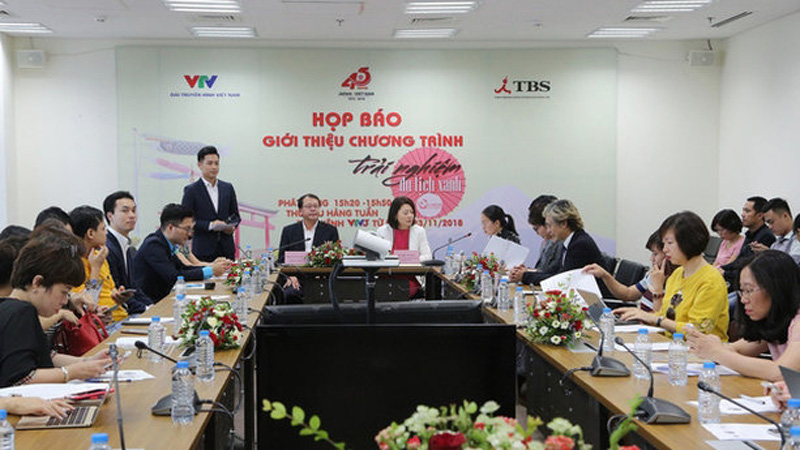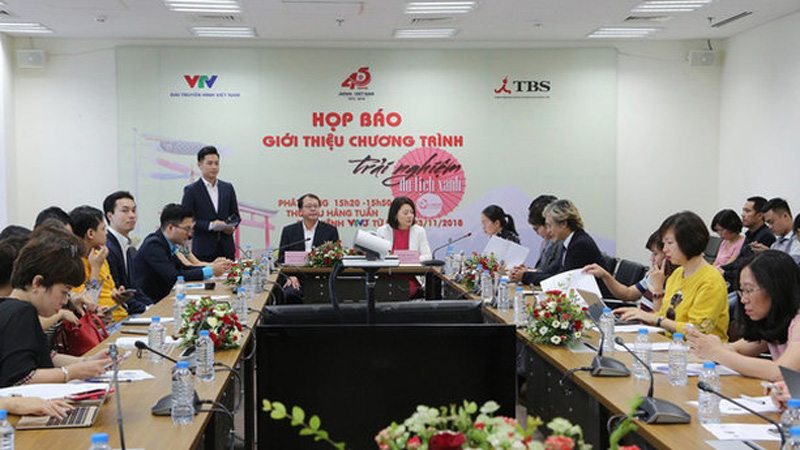
The programme titled ‘Colours of Japan – Experience of green tourism’ will be aired at 3:20pm every Friday on VTV3, of Vietnam Television (VTV), from November 23.

The press conference
on the programme.
The five-episode programme is jointly produced by the VTV
and the Tokyo Broadcasting System (TBS), aiming to celebrate the 45th
anniversary of the establishment of ties between Vietnam and Japan.
The programme will introduce Vietnamese audiences to nature
and clean energy as well as self-contained production processes addressing
environmental protection and sustainable development in Japan.
The programme was divided into five episodes titled
‘Experience of catching octopus in Kanagawa province’, ‘Experience of making
traditional pottery in Nagasaki’, ‘Experience of cooking in Nouhaku’, ‘Experience
of fishing net pulling in Wakayama’, and ‘Experience of Onsen bathing in Oita’.
The two characters involved in the experience are editor Le
Bao An and actress Le Chi, who visited Japan for the first time. They get
closer to Japanese culture and help Vietnamese audiences to know more about the
nature and the simple life of Japanese people.
The previous series of ‘Colours of Japan’ were
broadcast in 2016, 2017 and January 2018.
Source: NDO
With an increasingly vibrant and widespread emulation movement aimed at building cultured residential areas and cultured families, Yen Thuy District has been making steady progress toward improving both the material and spiritual well-being of its people, while fostering a civilized, prosperous, beautiful, and progressive community.
Once lacking recreational spaces and community facilities, Residential Group 2 in Quynh Lam Ward (Hoa Binh City) has recently received attention for the construction of a new, spacious, and fully equipped cultural house. The project followed the model of state support combined with public contributions in both labor and funding.
The "All people unite to build cultural life" movement, which has been effectively integrated with Kim Boi district’s socio-economic development goals, is fostering a lively spirit of emulation across local residential areas, hamlets, villages, public agencies, and enterprises. In addition, through the initiative, traditional cultural values are being preserved and promoted, while community solidarity and mutual support in poverty reduction and economic development are being strengthened.
A working delegation of the Hoa Binh provincial People’s Committee led by its Permanent Vice Chairman Nguyen Van Toan on June 11 inspected the progress of a project to build the Mo Muong Cultural Heritage Conservation Space linked to tourism services in Hop Phong commune, Cao Phong district.
Born and growing in the heroic land of Muong Dong, Dinh Thi Kieu Dung, a resident in Bo town of Kim Boi district, in her childhood was nurtured by the sweet lullabies of her grandmother and mother. These melodies deeply imprinted on her soul, becoming an inseparable part of her love for her ethnic group's culture. For over 20 years, this love for her hometown has driven Dung to research, collect, and pass down the cultural values of the Muong people to future generations.
In the final days of May, the Ethnic Art Troupe of Hoa Binh Province organized performances to serve the people in remote, mountainous, and particularly disadvantaged areas within the province. These were not just ordinary artistic shows, but they were the meaningful journeys aimed at spreading cultural values, enhancing the spiritual life of the people and contributing to the preservation of ethnic minority cultural identities.



